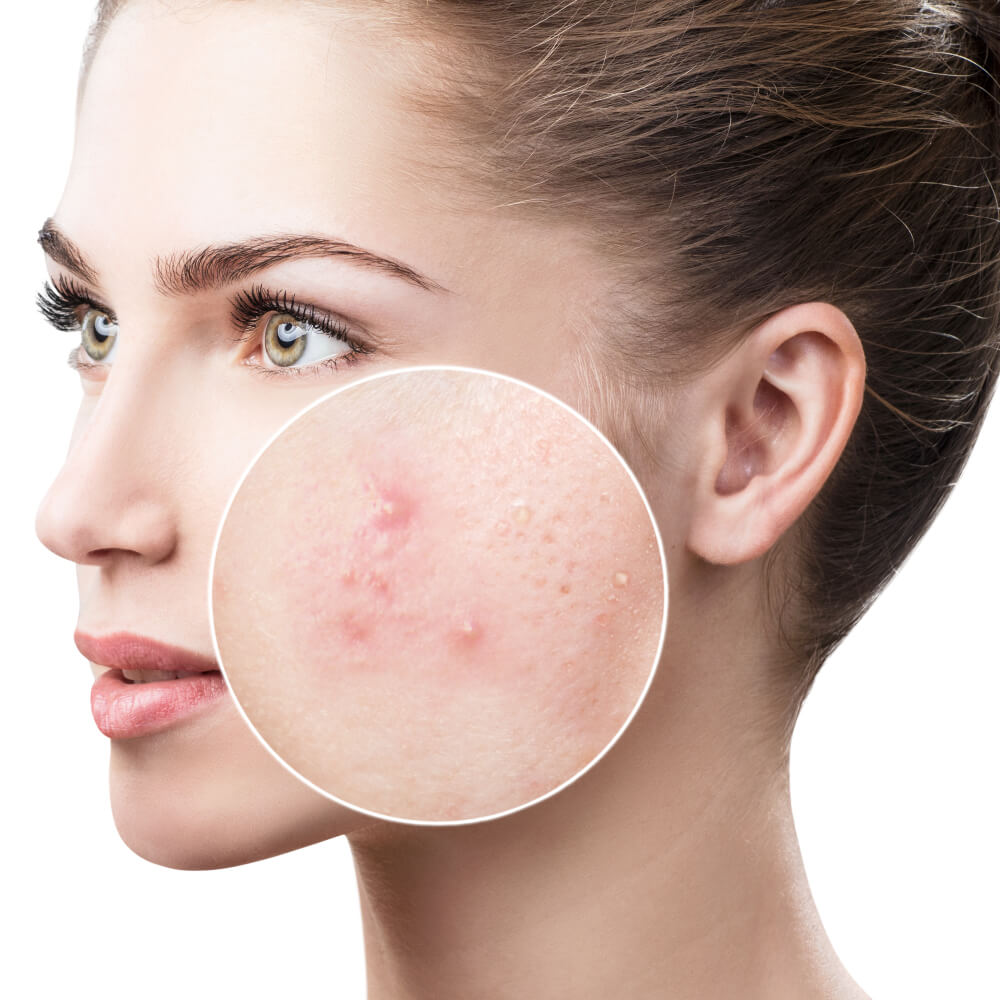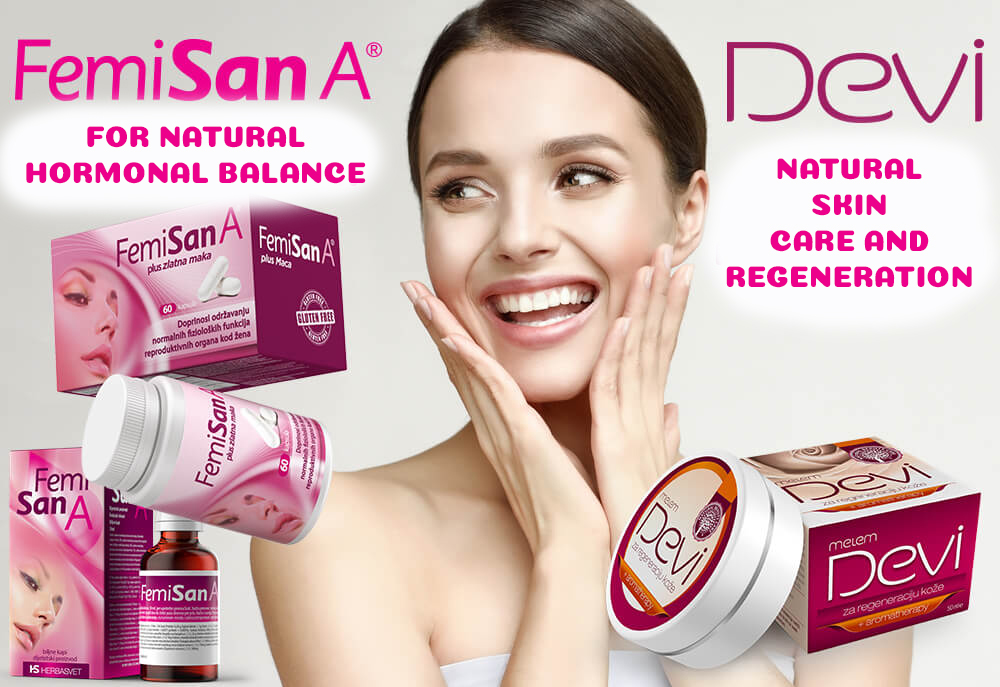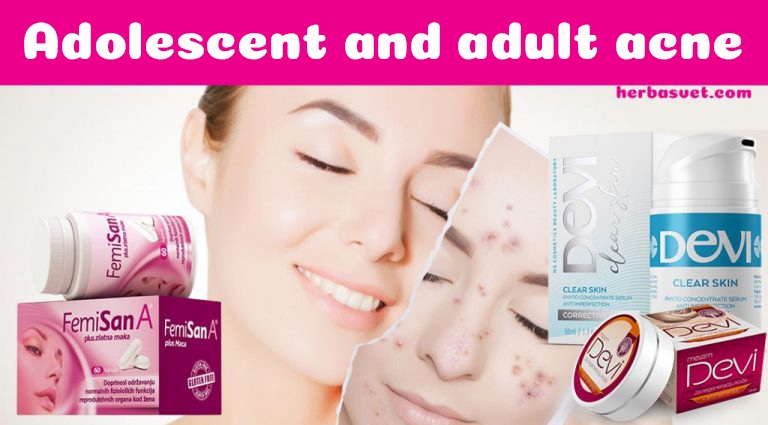The whole body begins to change when the first surge of hormones occurs during puberty, and the previously smooth facial skin can begin to resemble a battlefield marked by red and swollen pimples. Hormonal acne is a normal phenomenon during puberty due to the increase in testosterone levels in both sexes, which plays its own important role – it gives boys the physical characteristics of a man, while in girls it helps strengthen muscles and bones and contributes to the establishment of the monthly cycle. Testosterone during this youthful metamorphosis may give the sebaceous glands a good shakeup, and lead to oily skin with increased production of sebum around the hair roots. Although sebum has its purpose – to protect and moisturise the skin – when there is too much of it, it combines with dead skin cells, clogs up hair follicles and thus causes acne.
WHAT IS ACNE?
Acne (Acne vulgaris) is the most common inflammation of the skin that occurs in three phases: seborrhea – when excess sebum is produced, but changes on the surface of the skin cannot be yet seen; hyperkeratosis – when a thickening and protrusion is formed on the surface of the skin due to increased production of corneocytes, skin cells in the ducts of sebaceous glands, which together with dead cells retain excess sebum. As the trapped sebum blocks the duct and the work of the sebaceous glands, the hair follicle gets filled with pus. This is an ideal ground for the development of bacteria. This is when the third phase occurs, the bacterial one, when the bacterium Propionibacterium acnes (P. acnes) breaks down the trapped sebum and thus causes inflammation under the skin. At this stage, acne is very visible, the skin around it is red and inflamed, and the top of the acne itself can be black or white.

As puberty passes and hormones stabilise and calm down, so does acne. It should be so, but unfortunately, acne developing in adults has been on the rise in the past few decades. According to the latest estimates, as many as 50 per cent of women aged 20-29 suffer from this skin disease. Only half of them will get rid of them later, and 25 percent of women will continue to deal with this problem in their forties. Acne in adulthood differs from the adolescent form of acne and requires a special approach.
WHAT CAUSES ACNE?
Why is this happening, and why are we currently witnessing a real epidemic of acne, often in severe forms? Apart from the fact that some people are prone to acne and have sensitive skin, we know that this unpleasant phenomenon is caused by hormones; today more than ever we are flooded with hormone disruptors in our immediate environment. They are disguised as everything that at first glance saves us time and increases the quality of life: fast food full of additives and trans-fats, sweets that are easily available everywhere, plastic storage boxes for food, plastic cups and bottles, carbonated drinks, non-stick pans used to prepare food quickly and detergents and hygiene products. However, they are also found in basic foods: fruit and vegetables that have been treated with pesticides, meat and milk that are full of antibiotics and hormones… All the things that seem to save us time, actually steal it from us.
The normal natural hormonal balance is disrupted by high-tech products. Women are especially susceptible to this, as they go through a regular change of hormones every month, which is part of the normal reproductive cycle. But when the balance of hormones is disturbed, disorders occur that are most often manifested in the form of irregular periods, cysts, fibroids, polycystic ovary syndrome (PCOS) and acne.

POLYCYSTIC OVARIES AND HORMONAL ACNE
PCOS is particularly and often associated with acne in women during the reproductive phase of life. This complex disorder is characterised by the formation of many small cysts on the ovaries and is caused by an elevated level of androgenic hormones. PCOS is accompanied by the absence of periods, increased body hairiness and thinning of hair, obesity, insulin resistance, diabetes and the appearance of acne. It goes without saying that all this puts pressure on a woman’s mental health.
During menopause, the drop in oestrogen and progesterone and the increase in androgenic hormones can lead to a new outbreak of hormonal acne. In addition to androgenic hormones, the appearance of acne can also be triggered by stress, or the hormone cortisol. When they are caused by hormonal changes in women, pimples usually appear in the chin and jaw area, they increase and decrease cyclically, just like the menstrual cycle itself, and they usually appear in the same place, that is, in the pores that have already been enlarged by previous pimples.
HOW TO FIGHT HORMONAL ACNE?
No matter how irritating it is to see hormonal acne on one’s face, they should never be touched or squeezed. An examination by a dermatologist who will prescribe appropriate therapy and care is necessary. The face should be washed in moderation, using mild soaps and scrubs. What can significantly worsen acne and skin inflammation are heavy makeup and the bad habit of going to bed without thoroughly removing makeup and cleaning the face.

Although taking contraceptive pills is the usual remedy that doctors prescribe against pimples that are caused by hormonal imbalance, the problem will most often return as soon as we stop using them. The treatment that is often prescribed is salicylic acid and bezoyl peroxide. However, it is possible to get rid of hormonal pimples in a natural way. Natural solutions require more time and patience, but they pay off in the long run. The same goes for medicinal herbs. Femisan A is a completely natural preparation based on medicinal plants that helps to solve disorders of the female reproductive system by basically balancing hormone levels. It can also be used by girls, already from the first menstruation. When we get rid of the imbalance of hormones and the levels of oestrogen and testosterone are restored, acne will disappear with adequate care and nutrition. But this will not happen overnight. With herbal preparations, regular and long-term use is very important, and even when the problem is solved, it is good to continue taking the preventive dose for a while.
It is also very important to pay attention to nutrition. Food rich in simple carbohydrates and fats, such as ready-made pastries made of white flour, fried food, snacks, chocolate bars and industrial cakes will not only contribute to the formation of fat deposits on the body, but will certainly affect our hormones as well. Acne can be kept under control with a healthy lifestyle. If we try to solve hormonal acne with one therapy, and continue with the lifestyle that leads to it, we will not achieve good or long-lasting results.
Unfortunately, even when acne goes away, it can leave nasty scars after more severe inflammation. That is when Devi regeneration balm comes into play. This high-quality balm based on natural oils and beeswax calms inflammatory processes, regulates moisture, has an antiseptic, bactericidal and fungicidal effect, leads to faster regeneration of damaged skin epidermis and reduces scars and hyperpigmentation. Cosmetic products for facial skin care should be chosen carefully; one should never apply heavy and low-quality creams that further burden the activity of the sebaceous glands and cause inflammation on the skin. We should also think about sun protection. An excellent choice is the high-quality Devi cosmetics range.
Acne is persistent and therefore we must be too. There will definitely come a moment when we look in the mirror and realise that our persistence has paid off.

